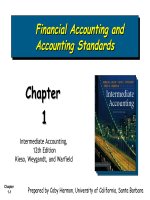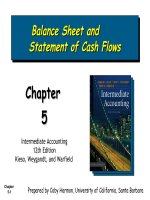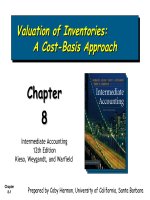Intermediate accounting 12th edition kieso warfield chapter 17
Bạn đang xem bản rút gọn của tài liệu. Xem và tải ngay bản đầy đủ của tài liệu tại đây (376.52 KB, 44 trang )
Investments
Investments
Chapter
17
Intermediate Accounting
12th Edition
Kieso, Weygandt, and Warfield
Chapter
17-1
Prepared by Coby Harmon, University of California, Santa Barbara
Learning
Learning Objectives
Objectives
1.
Identify the three categories of debt securities and describe
the accounting and reporting treatment for each category.
2.
Understand the procedures for discount and premium
amortization on bond investments.
3.
Identify the categories of equity securities and describe the
accounting and reporting treatment for each category.
4.
Explain the equity method of accounting and compare it to
the fair value method for equity securities.
5.
Describe the disclosure requirements for investments in debt
and equity securities.
6.
Discuss the accounting for impairments of debt and equity
investments.
7.
Describe the accounting for transfer of investment securities
between categories.
Chapter
17-2
Investments
Investments
Investments in Debt
Securities
Chapter
17-3
Investments in
Equity Securities
Other Reporting
Issues
Held-to-maturity
securities
Holdings of less than
20%
Financial statement
presentation
Available-for-sale
securities
Holdings between 20%
and 50%
Impairment of value
Trading securities
Holdings of more than
50%
Transfers between
categories
Fair value
controversy
Investments
Investments
Different motivations for investing:
To earn a high rate of return.
To secure certain operating or financing
arrangements with another company.
Chapter
17-4
Investments
Investments
Companies account for investments based on
the type of security (debt or equity) and
their intent with respect to the investment.
Illustration 17-1
Chapter
17-5
Investments
Investments in
in Debt
Debt Securities
Securities
Debt securities (creditor relationship):
Type
Accounting
Category
U.S. government
securities
Held-to-maturity
Municipal securities
Trading
Corporate bonds
Available-for-sale
Convertible debt
Commercial paper
Chapter
17-6
LO 1 Identify the three categories of debt securities and describe
the accounting and reporting treatment for each category.
Investments
Investments in
in Debt
Debt Securities
Securities
Accounting for Debt Securities by Category
Illustration 17-2
Chapter
17-7
LO 1 Identify the three categories of debt securities and describe
the accounting and reporting treatment for each category.
Held-to-Maturity
Held-to-Maturity Securities
Securities
Classify a debt security as held-to-maturity only
if it has both
(1) the positive intent and
(2) the ability to hold securities to maturity.
Accounted for at amortized cost, not fair value.
Amortize premium or discount using the effectiveinterest method unless the straight-line method—
yields a similar result.
Chapter
17-8
LO 2 Understand the procedures for discount and
premium amortization on bond investments.
Held-to-Maturity
Held-to-Maturity Securities
Securities
E17-3 (Held-to-Maturity Securities) On January 1,
2006, Hi and Lois Company purchased 12% bonds, having a
maturity value of $300,000, for $322,744. The bonds
provide the bondholders with a 10% yield. They are dated
January 1, 2006, and mature January 1, 2011, with interest
receivable December 31 of each year. Hi and Lois Company
uses the effective-interest method to allocate
unamortized discount or premium. The bonds are classified
in the held-to-maturity category.
Instructions (a) Prepare the journal entry at the date of
the bond purchase.
Chapter
17-9
LO 2 Understand the procedures for discount and
premium amortization on bond investments.
Held-to-Maturity
Held-to-Maturity Securities
Securities
E17-3 (a) Prepare the journal entry at the date of the
bond purchase.
January 1, 2006:
Held-to-Maturity Securities
Cash
Chapter
17-10
322,744
322,744
LO 2 Understand the procedures for discount and
premium amortization on bond investments.
Held-to-Maturity
Held-to-Maturity Securities
Securities
E17-3 (b) Prepare a bond amortization schedule.
Date
Cash
Received
10%
Interest Premium
Revenue Amortized
1/1/06
$ 322,744
12/31/06
$ 36,000
$ 32,274
$ 3,726
319,018
12/31/07
36,000
31,902
4,098
314,920
12/31/08
36,000
31,492
4,508
310,412
12/31/09
36,000
31,041
4,959
305,453
12/31/10
36,000
30,547 *
5,453
300,000
* rounding
Chapter
17-11
Carrying
Amount
LO 2 Understand the procedures for discount and
premium amortization on bond investments.
Held-to-Maturity
Held-to-Maturity Securities
Securities
E17-3 (c) (d) Prepare the journal entry to record the
interest received and the amortization for 2006 & 2007.
December 31, 2006:
Cash
36,000
Held-to-Maturity Securities
3,726
Interest Revenue
32,274
December 31, 2007:
Cash
Chapter
17-12
36,000
Held-to-Maturity Securities
4,098
Interest Revenue
31,902
LO 2 Understand the procedures for discount and
premium amortization on bond investments.
Available-for-Sale
Available-for-Sale Securities
Securities
Companies report available-for-sale securities at
fair value, with
unrealized holding gains and losses reported as
part of comprehensive income (equity).
Any discount or premium is amortized.
Chapter
17-13
LO 2 Understand the procedures for discount and
premium amortization on bond investments.
Available-for-Sale
Available-for-Sale Securities
Securities
E17-4 (Available-for-Sale Securities) Assume the same
information as in E17-3 except that the securities are
classified as available-for-sale. The fair value of the bonds
at December 31 for 2006 and 2007 is $320,500 and
$309,000, respectively.
Instructions
(a) Prepare the journal entry at date of bond purchase.
(b) Prepare the journal entries to record the interest
received and recognition of fair value for 2006.
(c) Prepare the journal entry to record recognition of fair
value for 2007.
Chapter
17-14
LO 2 Understand the procedures for discount and
premium amortization on bond investments.
Available-for-Sale
Available-for-Sale Securities
Securities
E17-4 (a) Prepare the journal entry at date of bond
purchase.
January 1, 2006:
Available-for-Sale Securities
Cash
Chapter
17-15
322,744
322,744
LO 2 Understand the procedures for discount and
premium amortization on bond investments.
Available-for-Sale
Available-for-Sale Securities
Securities
E17-4 (b) Prepare the journal entries to record the
interest received and recognition of fair value for 2006.
December 31, 2006:
Cash
36,000
Available-for-Sale Securities
3,726
Interest Revenue
32,274
Securities Fair Value Adjustment-AFS
Unrealized Holding Gain/Loss
1,482
1,482
($320,500 – $319,018 = $1,482)
Chapter
17-16
LO 2 Understand the procedures for discount and
premium amortization on bond investments.
Available-for-Sale
Available-for-Sale Securities
Securities
E17-4 (c) Prepare the journal entry to record recognition
of fair value for 2007.
December 31, 2007:
Unrealized Holding Gain/Loss
Securities Fair Value Adjustment-AFS
7,402
7,402
Available-for-sale bonds at cost
Available-for-sale bonds at fair value
Unrealized holding gain (loss)
Previous securities fair value adjustment—Dr.
Securities fair value adjustment—Cr.
Chapter
17-17
$
$
314,920
309,000
(5,920)
1,482
(7,402)
LO 2 Understand the procedures for discount and
premium amortization on bond investments.
Available-for-Sale
Available-for-Sale Securities
Securities
Sale of Available-for-Sale Securities
If company sells bonds before maturity date:
Must make entry to remove the,
Cost in Available-for-Sale Securities and
Securities Fair Value Adjustment accounts.
Any realized gain or loss on sale is reported in
the “Other expenses and losses” section of the
income statement.
Chapter
17-18
LO 2 Understand the procedures for discount and
premium amortization on bond investments.
Trading
Trading Securities
Securities
Companies report trading securities at
fair value, with
unrealized holding gains and losses reported as
part of net income.
Any discount or premium is amortized.
Chapter
17-19
LO 2 Understand the procedures for discount and
premium amortization on bond investments.
Trading
Trading Securities
Securities
BE17-4 (Trading Securities) Pete Sampras Corporation
purchased trading investment bonds for $40,000 at par. At
December 31, Sampras received annual interest of $2,000,
and the fair value of the bonds was $38,400.
Instructions
(a) Prepare the journal entry for the purchase of the
investment.
(b) Prepare the journal entries for the interest received.
(c) Prepare the journal entry for the fair value
adjustment.
Chapter
17-20
LO 2 Understand the procedures for discount and
premium amortization on bond investments.
Trading
Trading Securities
Securities
BE17-4 Prepare the journal entries for (a) the purchase of
the investment, (b) the interest received, and (c) the fair value
adjustment.
(a)
Trading securities
Cash
(b)
40,000
Cash
2,000
Interest revenue
(c)
2,000
Unrealized Holding Loss - Income
Securities Fair Value Adj.- Trading
Chapter
17-21
40,000
1,600
1,600
LO 2 Understand the procedures for discount and
premium amortization on bond investments.
Investments
Investments in
in Equity
Equity Securities
Securities
Represent ownership of capital stock.
Cost includes:
price of the security, plus
broker’s commissions and fees related to purchase.
The degree to which one corporation (investor)
acquires an interest in the common stock of another
corporation (investee) generally determines the
accounting treatment for the investment subsequent
to acquisition.
Chapter
17-22
LO 3 Identify the categories of equity securities and describe the
accounting and reporting treatment for each category.
Investments
Investments in
in Equity
Equity Securities
Securities
Ownership Percentages
0 --------------20% ------------ 50% -------------- 100%
Chapter
17-23
SFAS 115
APBO 18,
SFAS 142
No significant
influence
usually exists
Significant
influence
usually exists
Investment
valued using
Fair Value
Method
Investment
valued using
Equity
Method
SFAS 141,
SFAS 142
Control
usually exists
Investment valued on
parent’s books using Cost
Method or Equity Method
(investment eliminated in
Consolidation)
LO 3 Identify the categories of equity securities and describe the
accounting and reporting treatment for each category.
Holdings
Holdings of
of Less
Less Than
Than 20%
20%
Accounting Subsequent to Acquisition
Market Price
Available
Market Price
Unavailable
Value and report the
investment using the
fair value method.
Value and report the
investment using the
cost method.*
* Securities are reported at cost. Dividends are recognized when
received and gains or losses only recognized on sale of securities.
Chapter
17-24
LO 3 Identify the categories of equity securities and describe the
accounting and reporting treatment for each category.
Holdings
Holdings of
of Less
Less Than
Than 20%
20%
Accounting and Reporting – Fair Value Method
Because equity securities have no maturity date, companies cannot
classify them as held-to-maturity.
Chapter
17-25
LO 3 Identify the categories of equity securities and describe the
accounting and reporting treatment for each category.









